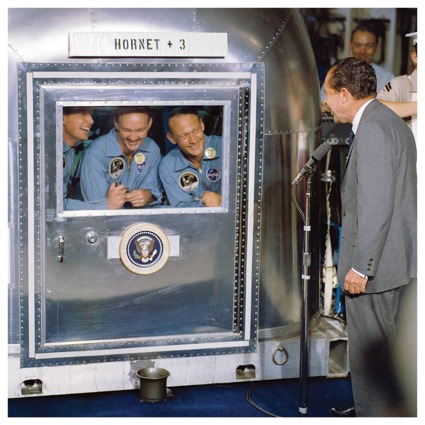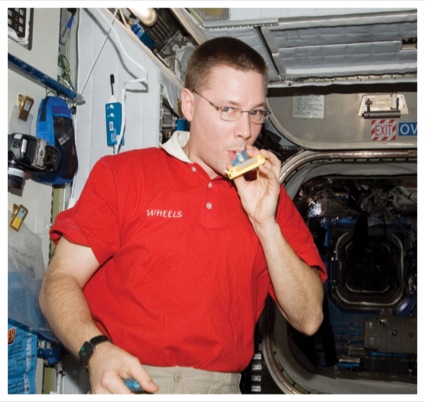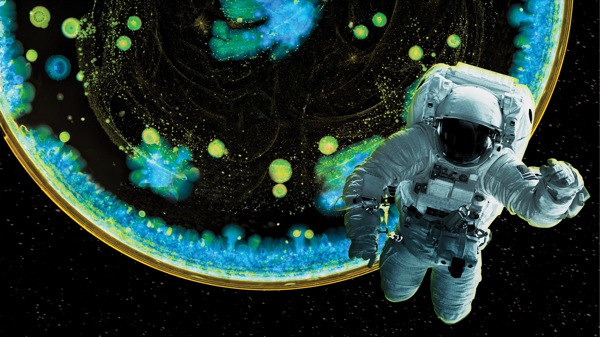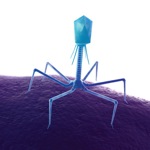By Marie Rosenthal, MS
The patients seen by James Pattarini, MD, MPH, are among the fittest in the world, but a reactivation of common viruses causes concern, and a stuffy nose could have multimillion-dollar consequences.
His patients are unique in that they travel to space, so every potential medical problem has to be viewed against issues, such as zero gravity, increased radiation and carbon dioxide levels—issues that don’t even cross the minds of his colleagues here on the ground. Astronauts also experience social stresses, such as isolation, anxiety and sleep deprivation, which can affect their immune system (Sci Rep [Epub Jul 9, 2019]. doi: 10.1038/s41598-019-46).
Infectious organisms are a particular concern, and quarantine is something that the folks at NASA take very seriously. In 1969, former President Richard M. Nixon wanted to shake the hands of the Apollo 11 astronauts prior to their historic launch, but he was told that was impossible because they were in quarantine. “Who says no to the president?” Dr. Pattarini asked. “The flight surgeon.”
And during the Apollo 13 mission, Ken Mattingly was removed from the manifest because he had been exposed to rubella. Although the Command Module pilot never came down with German measles, NASA could not take the chance that he would develop symptoms during a critical phase of the mission or suffer an atypical manifestation of the three-day rash.
During the Space Shuttle era of shorter missions, quarantine began seven days prior to launch, explained Dr. Pattarini, who is a flight surgeon in the Space Medicine Operations Division at NASA-Johnson Space Center, in Houston. Today, with longer missions at the International Space Station (Iss) that involve an international crew, the quarantine is at least 14 days. (Operational concerns can delay a launch and cause a longer quarantine.)
“Our approach, ideally, is to capture two incubation periods back-to-back of the most common organisms. We are trying to prevent uphill transmission,” Dr. Pattarini said. “Our goal is to protect not only the launching crew but the crewmembers already onboard the Iss.”
Just as in a hospital, there are two potential sources of infection that have to be monitored continuously: the Iss environment, as well as the people coming in and out of that environment. They routinely sample the Iss, which has developed its own microbiome similar to what is seen in people’s homes, Dr. Pattarini explained. “Surfaces are swabbed and air samples are taken routinely,” he said.
In the past 19 years, there has been a continuous change of personnel on the Iss, but the crew overlap to maintain at least three people on board at all times. While aboard the Iss, the crew experiences physiologic stressors and immunologic changes that could affect their response to any organism. The new crew “will be joining people who have been in space for three to four months at a time, so they are essentially quarantined. You don’t want to put the orbit crew at potentially higher risk [due to exposure from the new crew],” Dr. Pattarini explained.
“We are concerned with what happens to the immune system during spaceflight,” added Brian Crucian, PhD, MT(ASCP), a scientist in the Immunology Laboratory at the NASA-Johnson Space Center. “[Crew members] experience multiple physiological stressors across their mission. That’s documented by some of the stress hormone measurements we see and reductions in peripheral blood immune cell funtion.”
Both innate and adaptive immune responses seem to be suppressed by long-term spaceflight. Astronauts produce an increased number of neutrophils, monocytes, T-helper cells and B cells, and they see a decrease in the production of natural killer cells, the synthesis of alpha- and beta-interferon, and hypoplasia in the lymphoid system. Although women also experience immune changes, their immune response in space is stronger than men’s (Infect Drug Resist 2015;8:249-262).
An interesting phenomenon seen on the Iss is a subclinical reactivation of multiple latent herpesviruses, according to Satish K. Mehta, PhD, a virologist at the Johnson Space Center-SK Wyle Laboratories. More than half of the astronauts tested shed herpes simplex virus 1 (HSV-1), Epstein-Barr virus, varicella-zoster virus (VZV) and/or cytomegalovirus during and after long-term spaceflight (NPJ Microgravity 2017;3:11).
However, this shedding “does not directly translate into clinical disease,” Dr. Mehta said. “During space flight, stress hormones such as cortisol and DHEA [dehydroepiandrosterone] increase, and the immune system does decrease or change, thus resulting in latent herpesvirus reactivation,” he explained. “In a sense, [the viruses] just wake up and start to replicate and shed in saliva, urine, blood and other bodily fluids.”
VZV is of particular interest, Dr. Mehta said. Following primary infection, the virus becomes latent in ganglionic neurons for the life of the individual and in about 30% of people with latent virus, VZV reactivates, causing shingles. Being a neurotropic virus, it was thought not to be present or shed in saliva. “Our studies showed for the first time that VZV and other herpesviruses could be detected in saliva. Our virus detection protocols developed from spaceflight studies are being used routinely in various hospital settings and research insitutes like NIH, CDC, the University of Colorado and Columbia University,” he said. This helps with the early diagnosis and management of the disease.
The immune system reverts to normal when Iss crewmembers return to Earth, according to Dr. Mehta. Before it does, they could shed infectious virus, which could pose a potential threat to immunocompromised and seronegative individuals.
Today’s quarantine protocol prevents many infections, but there have been a handful of localized infections, such as conjunctivitis, infectious diarrhea and upper respiratory tract infections. There were 26 reports of infection between 1989 and 1998 during the space shuttle program, when the nominal quarantine time was only seven days.
Cosmonaut Yury Romanenko suffered a dental infection that could not be taken care of until he returned to Earth from an extended Salyut 6 flight (J Gr Houston Dental Soc 1989;61:7).
A more common noninfectious condition that Dr. Pattarini sees among Iss inhabitants is space adaption syndrome, manifesting as nausea, disorientation and vomiting due to neurovestibular dysfunction (Neurol India 2019;67[suppl]:S214-S218).
“With just the act of going into space, you get neurovistibular adaptation to spaceflight that comes along with nausea and vomiting for the first couple days for a pretty significant percentage of our population due to the normal function of the inner ear in an abnormal environment,” Dr. Pattarini said. “That is something we can manage. While it is self-limited, severe symptoms that can impair an astraunaut’s ability to work are something we try to prevent. We can treat with a range of antiemetics, antihistamines and anticholinergics.”
Gut motility changes are also a problem. “Everyone senses a change in gut motility when they go up that lasts for about a week, and then subjectivity improves,” Dr. Pattarini said. “Aside from the nausea, most crew will experience a decrease in appetitie during their first one to two weeks in space. The questions of whether gastric and gut motility fully return to terrestrial baseline, or whether other facters like fluid shifts due to microgravity may impact nutrient and drug absorption are open, and interesting ones.”
Another common problem is contact dermatitis, and wounds and injuries that could place Iss crew at risk for infection. “There are a range of minor to moderate injuries that we are used to responding to inflight,” he said.
The onboard crew has to respond to any medical issue, and the Iss has nine medical kits with medications, including a range of antibiotics formulated for topical and systemic use, to enable astronauts to perform first aid, resuscitation, and even stitch up their own wounds under the direction of their earthbound clinicians.
“We strive to help treat crew members on orbit exactly as you would be treated on Earth,” Dr. Pattarini said. “And in the most cases, that is exactly what we are able to do.”
One active area of research is whether the higher radiation and CO2 levels that are 10 times the CO2 seen on Earth affect the pharmacodynamics of medications, according to Dr. Pattarini. Right now, most medication adjustments that might be needed depend on individual patient characteristics. For instance, gut motility could affect absorption of a medication.
“Gut motility is an easy thing to think about,” Dr. Patterini said. “If you take a pill, it’s got to be absorbed. It makes intuitive sense that if absorption or motility is affected, the efficacy of the drug may be altered, as well.”
But whether metabolism in space changes the way medications are absorbed or their efficacy is still being researched.
Deep Thinkers
The Iss is in lower orbit, only 254 miles from Earth. One of the luxuries of the Iss is that a medication on the ground could be delivered to the station in a matter of weeks if needed, and if a member was critically illl or injured, he or she could be brought back to Earth within 24 hours.
This luxury is gone as people head deeper into space. Right now, there are regular supply runs to the Iss to take care of restocking medical supplies.
“Every launch is an opportunity to resupply. If we discover that medications were expiring quicker, or that we had reduced confidence in their efficacy, the impact to me is, well, I just need to resupply more often.
“If we are going to the moon, where people will be living on Gateway for extended periods, it’s slightly more complicated,” Dr. Pattarini said. Although he could still resupply, it would be less often, more expensive and less reliable.
“Resupplying to the moon is not an insurmountable hurdle,” he said. “If we are going to Mars, everything the crew is going to need will either be sent with them or prepositioned ahead of time, and resupply is not something that can be counted upon.”
Deep space will increase the stressors that astronauts experience, and that could have even more profound immunologic changes. The big question right now is what will happen in deep space? Could that subclinical HSV-1 infection shed by an astronaut lead to a clinical infection in his or her crewmate?
“What is really going on? And what is the real clinical risk during flight?” asked Dr. Crucian, the immunologist. “Until that question is answered, what we are seeing remains an interesting research phenomenon observed during orbital spaceflight with select crewmembers experiencing manageable clinical outcomes.
“We can document all these changes in immunity, reductions in immune function, alterations in cytokine production, etc., and it is manifesting in vivo in the reactivation of these latent herpesviruses.
“We don’t see a persistent clinical problem on the Iss. But it’s a concern for deep space because all the stressors associated with orbital flight will increase in magnitude,” he said.
Deep space changes everything, he explained. “The radiation is elevated because you are beyond the Van Allen [radiation] belt. The missions are eventually going to be longer. When you start talking about lunar and Mars missions, you are going to have hazards that you don’t have in orbit, such as surface exposure and lunar dust. You are going to have more constraints on space and clinical care.”
For instance, astronauts on the Iss do exercises on a variety of specialized hardware to help stave off some of the effects of zero gravity. Their exercise capabilities will be dramatically reduced in deep space. “Essentially, we can’t take Iss to the moon, and so these large pieces of exercise equipment that help maintain physiology in orbit aren’t going with us,” Dr. Crucian said, because the living quarters will be smaller.
The Environment
All living things undergo changes in the space environment, according to Dr. Pattarini, including microorganisms. Although there have been no reports of unknown organisms in space, bacteria, viruses and fungi are adept at adapting to new environments, and there have been reports of increased virulence, which is always a concern.
Millions of organisms, both good and bad, inhabit the human body providing a range of pathogens that could emerge, reemerge or adapt in the deep space environment, and the most likely source of potential infection during a spaceflight will be the same source seen in schools, hospitals and workplaces all over the planet—the people.
Much of the research being done now is with an eye toward deep space exploration, all three experts said. “We have a proposal under review to study the mutations in herpesvirus DNA and other RNA viruses shed during spaceflight as compared with before and after,” Dr. Mehta said.
Research like this is important because scientists like Drs. Crucian and Mehta have to develop “countermeasures to prevent medical or clinical challenges to our astronauts during deep space missions.”
The sources reported no relevant financial relationships.







